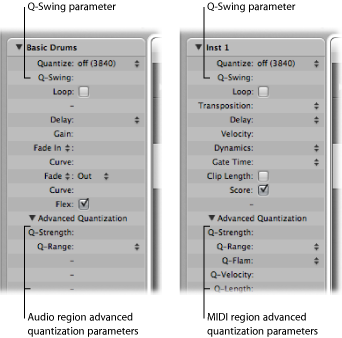Fine-Tuning the Quantize Grid Options
You can use the Q-Swing field and the advanced quantization parameters in the Region Parameter box to fine-tune your quantization grid. These provide a number of additional features that allow you to create and apply a swing or other quantize feel to your MIDI and software instrument parts.
The Q-Swing field is located just below the Quantize pop-up menu, and the rest of the quantization options listed below are in the Advanced Quantization section. They can be applied to any quantization value (except “off”).

Note: Not all advanced quantization parameters are available for audio regions.
- Q-Swing: Alters the position of every second point in the current quantization grid. Values over 50% delay the beats; values under 50% pre-delay them. The most practical settings fall between 50% and 75%, imparting a swing feel to strictly quantized (or tightly played) regions.
- Q-Strength: Determines how far a note or transient marker is shifted toward the nearest grid position. A value of 100% results in full quantization, and 0% leaves the note or transient marker at its recorded position.
- Q-Range: A very musical quantization strategy that requires a certain amount of technical musical prowess. Q-Range is ideal for recordings that already have the right groove but are too hurried or laid back in places. It allows you to retain the original feel, but positions the rhythmic center precisely in the groove. A value of 0 means that every note or transient marker is quantized. If you enter negative Q-Range values, only notes or transient markers that fall outside the set range are moved to ideal quantization grid positions, whereas those closer to an ideal position remain unquantized. This moves the most poorly played notes or transient markers—those outside the range—to perfect timing positions on the quantization grid, or at least moves them toward these positions, depending on the Q-Strength setting.
Tip: To obtain the best Q-Range results, use a low, even quantize value, such as 1/4 note. Set the Q-Range parameter to compensate for the maximum error in the recording.
- Q-Flam: Spreads out notes with the same time position—chords. Positive values produce an ascending (upward) arpeggio, negative values a descending (downward) arpeggio. The position of the first note—either the bottom or top note, assuming that all notes start at the same position—in the arpeggio is unaltered.
- Q-Velocity: Determines the amount that the velocity values of quantized notes are affected by the velocity values of a template MIDI region. At a value of 0%, the notes retain their original velocity. At 100%, they adopt the velocity values of the template. Negative values alter the velocity, making the deviation from the template even greater.
- Q-Length: Determines how the lengths of quantized notes are affected by the equivalent note lengths—notes at the same position—of a template MIDI region. A value of 0% has no effect, whereas at 100% the notes adopt the exact note lengths of the template region. Negative values alter note lengths further, resulting in a more significant deviation from the template.